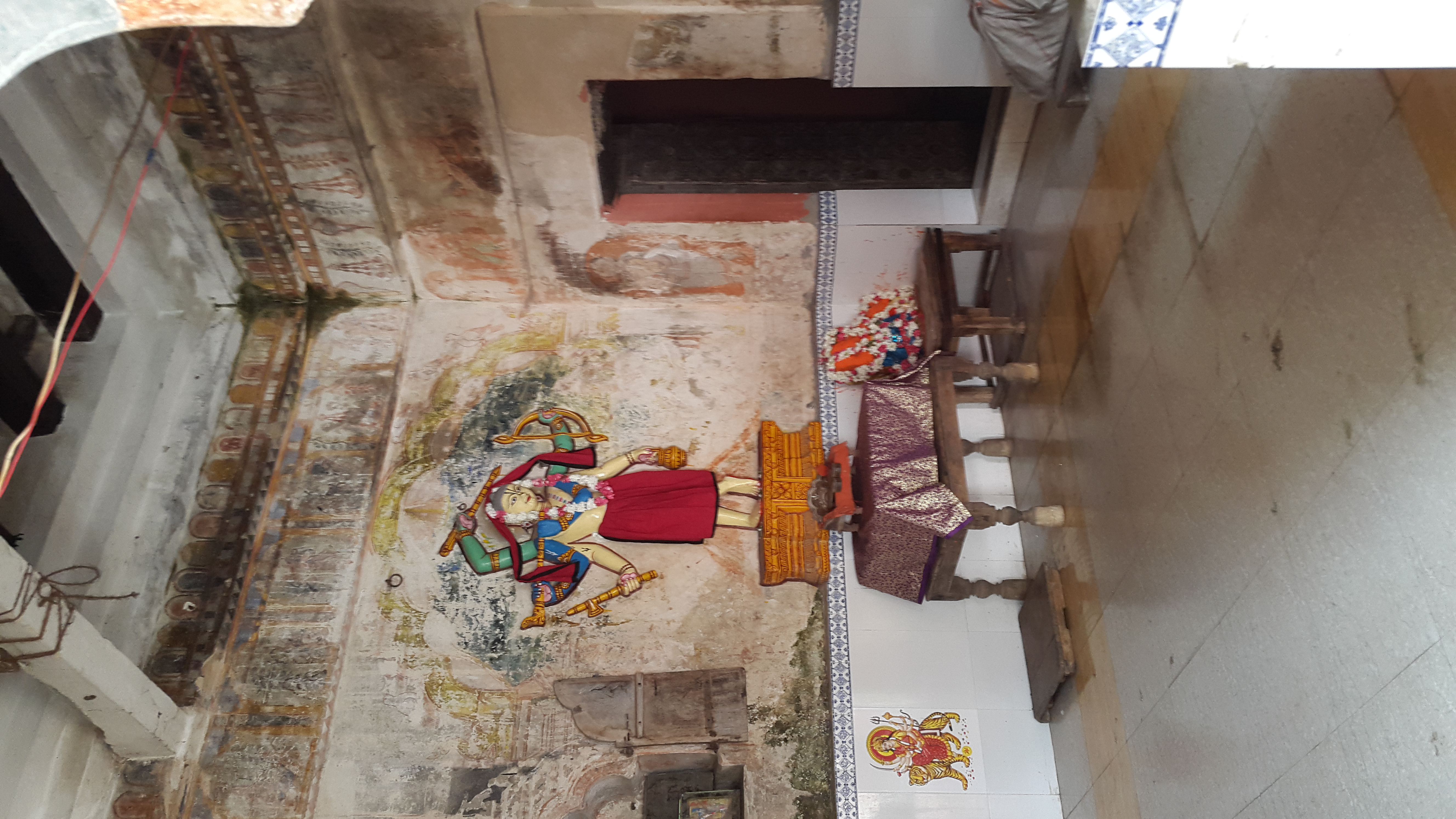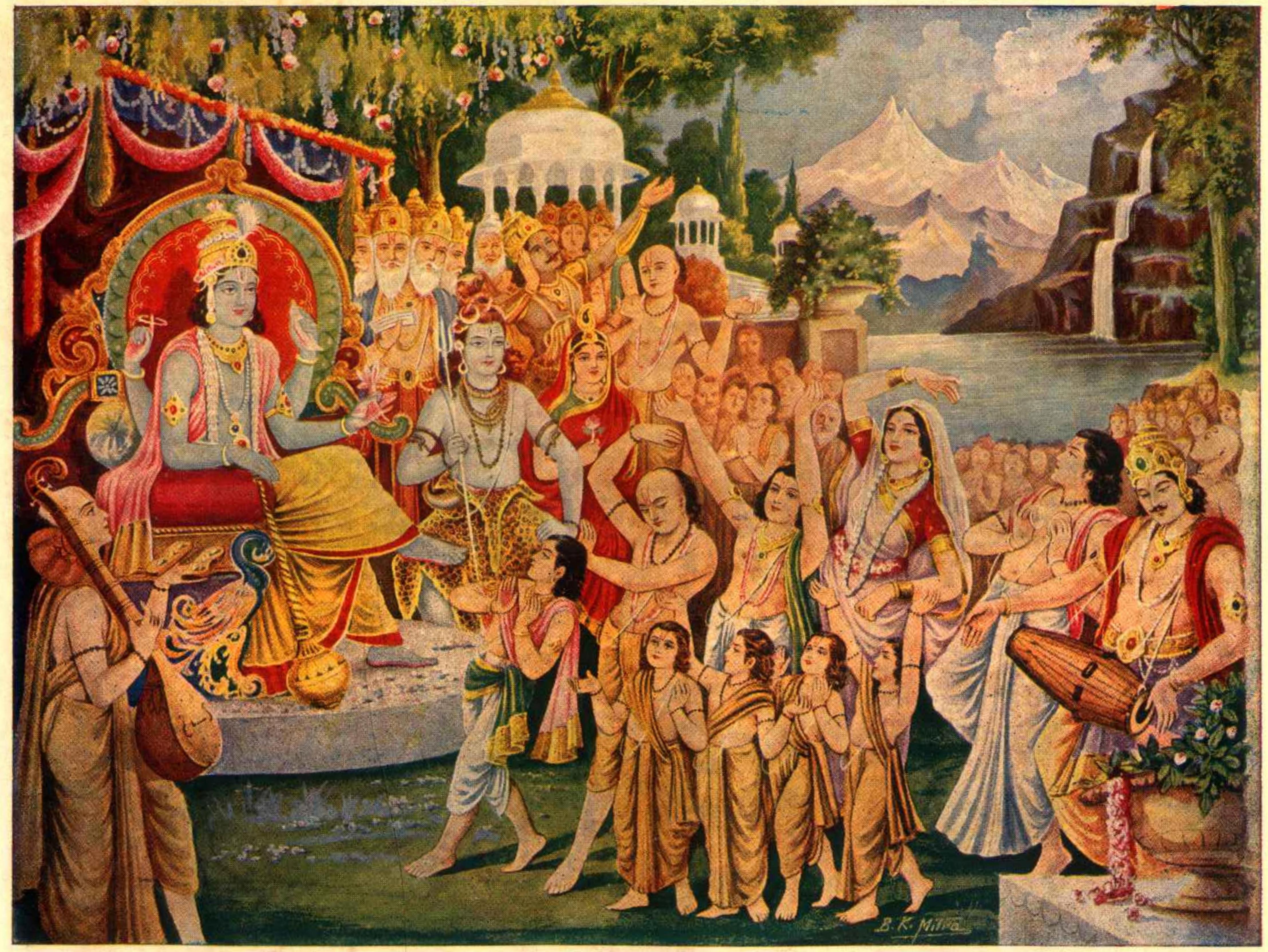|
Sri Chaitanya Mahaprabhu
Chaitanya Mahaprabhu (; born Vishvambhar Mishra) was a 15th-century Indian saint who is considered to be the combined avatar of Radha and Krishna by his disciples and various scriptures. Chaitanya Mahaprabhu's mode of worshipping Krishna with ecstatic song and dance had a profound effect on Vaishnavism in Bengal. He was also the chief proponent of the Vedantic philosophy of Achintya Bheda Abheda Tattva. Mahaprabhu founded Gaudiya Vaishnavism ( the Brahma-Madhva-Gaudiya Sampradaya). He expounded Bhakti yoga and popularized the chanting of the Hare Krishna Maha-mantra. He composed the '' Shikshashtakam'' (eight devotional prayers). Chaitanya is sometimes called Gauranga or Gaura due to his molten gold–like complexion. His birthday is celebrated as Gaura-purnima. He is also called Nimai due to him being born underneath a Neem tree. Life '' Chaitanya'' means "one who is conscious" (derived from Chetana, which means "Consciousness"); ''Maha'' means "Great" and ''Prabhu ... [...More Info...] [...Related Items...] OR: [Wikipedia] [Google] [Baidu] |
Hinduism
Hinduism () is an Indian religion or '' dharma'', a religious and universal order or way of life by which followers abide. As a religion, it is the world's third-largest, with over 1.2–1.35 billion followers, or 15–16% of the global population, known as Hindus. The word ''Hindu'' is an exonym, and while Hinduism has been called the oldest religion in the world, many practitioners refer to their religion as '' Sanātana Dharma'' ( sa, सनातन धर्म, lit='the Eternal Dharma'), a modern usage, which refers to the idea that its origins lie beyond human history, as revealed in the Hindu texts. Another endonym is ''Vaidika dharma'', the dharma related to the Vedas. Hinduism is a diverse system of thought marked by a range of philosophies and shared concepts, rituals, cosmological systems, pilgrimage sites, and shared textual sources that discuss theology, metaphysics, mythology, Vedic yajna, yoga, agamic rituals, and temple building, among other to ... [...More Info...] [...Related Items...] OR: [Wikipedia] [Google] [Baidu] |
Jiva Goswami
Jiva Goswami ( sa, जीव गोस्वामी, Jīva Gosvāmī; ) was an Indian philosopher and saint from the Gaudiya Vaishnava school of Vedanta tradition, producing a great number of philosophical works on the theology and practice of Bhakti yoga, Vaishnava Vedanta and associated disciplines. He is known as one of the Six Goswamis of Vrindavan and was the nephew of the two leading figures, Rupa Goswami and Sanatana Goswami. Biography Genealogy His family lineage can be traced to Indian State of Karnataka and Naihati in the district of North 24 Parganas in present-day West Bengal, India. The former generations according to ''Bhakti-ratnakara'': Sarvajna Jagatguru was a famous brahmana, great scholar in all Vedas, respected Yajur-vedi of the Baradvaja caste, and king of Karnataka in South India, adored by all other contemporary kings. Sarvajna's son, Aniruddha, was spirited, famous, a proficient scholar of the Vedas, and a favorite of the reigning kings at the t ... [...More Info...] [...Related Items...] OR: [Wikipedia] [Google] [Baidu] |
Gaura-purnima
Gaura Purnima is a Vaishnava festival that celebrates the appearance of the Supreme Personality of Godhead Sri Chaitanya Mahaprabhu (1486–1534), who founded Gaudiya Vaishnavism. It occurs on the Purnima (Full moon day) in the Hindu month Phalguna, usually falling in March or April. Gaura Purnima means "Golden Full Moon", a reference to Chaitanya. His followers spend this festival fasting and chanting congregationally, then at moonrise a feast is enjoyed by all. It was celebrated on 1 March in 2018 likewise in 2019 the very auspicious day will be witnessed on or around March 21. This festival is celebrated by Gaudiya Vaishnavas as part of Nabadwip-mandala Parikrama.{{cite web, url=http://www.newgovardhana.net/node/241 , title=Gaura Purnima-ISKCON New Govardhana , publisher=www.newgovardhana.net , accessdate=2008-12-16 , url-status=dead , archiveurl=https://web.archive.org/web/20080907180258/http://www.newgovardhana.net/node/241 , archivedate=September 7, 2008 See also *Caita ... [...More Info...] [...Related Items...] OR: [Wikipedia] [Google] [Baidu] |
Gauranga
Gauranga is another name for Chaitanya Mahaprabhu (or Gauranga Mahaprabhu), the 16th century Bengali avatar and founder of Gaudiya Vaishnavism. The term ''Gauranga Mahaprabhu'' references Lord Chaitanya possessing the golden complexion of Srimati Radharani as an incarnation or avatar of Krishna. Nomenclature * 'Gauranga' (Bengali ; Sanskrit गौराङ्ग; IAST: Gaurāṅga) means 'having a white, yellowish, or golden complexion'. The term is a bahuvrihi compound from: **'Gaura' (Sanskrit गौर) which means 'fair', 'gold', 'yellow', and 'saffron' (in complexion) ** 'Anga' (or 'aGga', Sanskrit अङ्ग) which means 'limb', 'constituent', and 'component part' (of Krishna) Gaudiya Vaishnavism the term 'Gauranga' is relevant in Gaudiya Vaishnavism due to scriptural verses such as the following found in the ''Bhagavata Purana'': 'Krsna' (or 'Krishna', Sanskrit कृष्ण) means 'black'; 'Akṛṣṇam' ('a-krsna-m') means 'not black' or 'golden'. 'Gauran ... [...More Info...] [...Related Items...] OR: [Wikipedia] [Google] [Baidu] |
Bhagavad Gita
The Bhagavad Gita (; sa, श्रीमद्भगवद्गीता, lit=The Song by God, translit=śrīmadbhagavadgītā;), often referred to as the Gita (), is a 700- verse Hindu scripture that is part of the epic ''Mahabharata'' (chapters 23–40 of book 6 of the Mahabharata called the Bhishma Parva), dated to the second half of the first millennium BCE and is typical of the Hindu synthesis. It is considered to be one of the holy scriptures for Hinduism. The Gita is set in a narrative framework of a dialogue between Pandava prince Arjuna and his guide and charioteer Krishna. At the start of the dharma yuddha (or the "righteous war") between the Pandavas and the Kauravas, Arjuna is preoccupied by a moral and emotional dilemma and despairs about the violence and death the war will cause in the battle against his kin. Wondering if he should renounce the war, he seeks Krishna's counsel, whose answers and discourse constitute the Gita. Krishna counsels Arjuna to "fu ... [...More Info...] [...Related Items...] OR: [Wikipedia] [Google] [Baidu] |
Hare Krishna (mantra)
The Hare Krishna mantra, also referred to reverentially as the ("Great Mantra"), is a 16-word Vaishnava mantra which is mentioned in the Kali-Santarana Upanishad and which from the 15th century rose to importance in the Bhakti movement following the teachings of Chaitanya Mahaprabhu. This mantra is composed of three Sanskrit names – "Krishna", "Rama", and "Hare". Since the 1960s, the mantra has been made well known outside India by A. C. Bhaktivedanta Swami Prabhupada and his movement, International Society for Krishna Consciousness (commonly known as the "Hare Krishnas" or the Hare Krishna movement). Mantra The Hare Krishna mantra is composed of Sanskrit names: ''Hare'', ''Krishna,'' and ''Rama'' (in Anglicized spelling). It is a poetic stanza in meter (a quatrain of four lines () of eight syllables with certain syllable lengths for some of the syllables). The mantra as rendered in the oldest extant written source, the Kali-Saṇṭāraṇa Upaniṣad, is as follows: ... [...More Info...] [...Related Items...] OR: [Wikipedia] [Google] [Baidu] |
Brahma Sampradaya
In Hinduism, the Brahma Sampradaya () is the disciplic succession (''sampradaya'') of gurus starting with Brahma. The term is most often used to refer to the beliefs and teachings of Madhvacharya, his Dvaita Vedanta philosophy and Sadh Vaishnavism, Vaishnavism section founded by Madhvacharya. The longer-term Brahma-Madhva-Gaudiya Sampradaya (), or simply Madhva-Gaudiya Sampradaya, is used to refer to the teachings of Chaitanya Mahaprabhu and his Gaudiya Vaishnava theology. Lynn Teskey Denton, 2004 - 224 pages Followers of this tradition believe that knowledge descends from Brahma. In the Vedic conception, these sampradayas ... [...More Info...] [...Related Items...] OR: [Wikipedia] [Google] [Baidu] |
Bengal
Bengal ( ; bn, বাংলা/বঙ্গ, translit=Bānglā/Bôngô, ) is a geopolitical, cultural and historical region in South Asia, specifically in the eastern part of the Indian subcontinent at the apex of the Bay of Bengal, predominantly covering present-day Bangladesh and the Indian state of West Bengal. Geographically, it consists of the Ganges-Brahmaputra delta system, the largest river delta in the world and a section of the Himalayas up to Nepal and Bhutan. Dense woodlands, including hilly rainforests, cover Bengal's northern and eastern areas, while an elevated forested plateau covers its central area; the highest point is at Sandakphu. In the littoral southwest are the Sundarbans, the world's largest mangrove forest. The region has a monsoon climate, which the Bengali calendar divides into six seasons. Bengal, then known as Gangaridai, was a leading power in ancient South Asia, with extensive trade networks forming connections to as far away as Roman Egypt. ... [...More Info...] [...Related Items...] OR: [Wikipedia] [Google] [Baidu] |
Vaishnavism
Vaishnavism ( sa, वैष्णवसम्प्रदायः, Vaiṣṇavasampradāyaḥ) is one of the major Hindu denominations along with Shaivism, Shaktism, and Smartism. It is also called Vishnuism since it considers Vishnu as the sole Para Brahman, supreme being leading all other Hindu deities, i.e. ''Mahavishnu''. Its followers are called Vaishnavites or ''Vaishnava''s (), and it includes sub-sects like Krishnaism and Ramaism, which consider Krishna and Rama as the supreme beings respectively. According to a 2010 estimate by Johnson and Grim, Vaishnavism is the largest Hindu sect, constituting about 641 million or 67.6% of Hindus. The ancient emergence of Vaishnavism is unclear, and broadly hypothesized as a History of Hinduism, fusion of various regional non-Vedic religions with Vishnu. A merger of several popular non-Vedic theistic traditions, particularly the Bhagavata cults of Vāsudeva, Vāsudeva-krishna and ''Gopala-Krishna, Gopala-Krishna'', and Narayana, ... [...More Info...] [...Related Items...] OR: [Wikipedia] [Google] [Baidu] |
Kirtan
Kirtana ( sa, कीर्तन; ), also rendered as Kirtan, is a Sanskrit word that means "narrating, reciting, telling, describing" of an idea or story, specifically in Indian religions. It also refers to a genre of religious performance arts, connoting a musical form of narration or shared recitation, particularly of spiritual or religious ideas, native to the Indian subcontinent. With roots in the Vedic ''anukirtana'' tradition, a kirtan is a call-and-response style song or chant, set to music, wherein multiple singers recite or describe a legend, or express loving devotion to a deity, or discuss spiritual ideas. It may include dancing or direct expression of ''bhavas'' (emotive states) by the singer. Many kirtan performances are structured to engage the audience where they either repeat the chant,Sara Brown (2012), ''Every Word Is a Song, Every Step Is a Dance'', PhD Thesis, Florida State University (Advisor: Michael Bakan), pages 25-26, 87-88, 277 or reply to the call of ... [...More Info...] [...Related Items...] OR: [Wikipedia] [Google] [Baidu] |
Krishna
Krishna (; sa, कृष्ण ) is a major deity in Hinduism. He is worshipped as the eighth avatar of Vishnu and also as the Supreme god in his own right. He is the god of protection, compassion, tenderness, and love; and is one of the most popular and widely revered among Indian divinities. Krishna's birthday is celebrated every year by Hindus on Krishna Janmashtami according to the lunisolar Hindu calendar, which falls in late August or early September of the Gregorian calendar. The anecdotes and narratives of Krishna's life are generally titled as ''Krishna Leela''. He is a central character in the ''Mahabharata'', the '' Bhagavata Purana'', the ''Brahma Vaivarta Purana,'' and the '' Bhagavad Gita'', and is mentioned in many Hindu philosophical, theological, and mythological texts. They portray him in various perspectives: as a god-child, a prankster, a model lover, a divine hero, and the universal supreme being. Quote: "Krsna's various appearances as a di ... [...More Info...] [...Related Items...] OR: [Wikipedia] [Google] [Baidu] |








